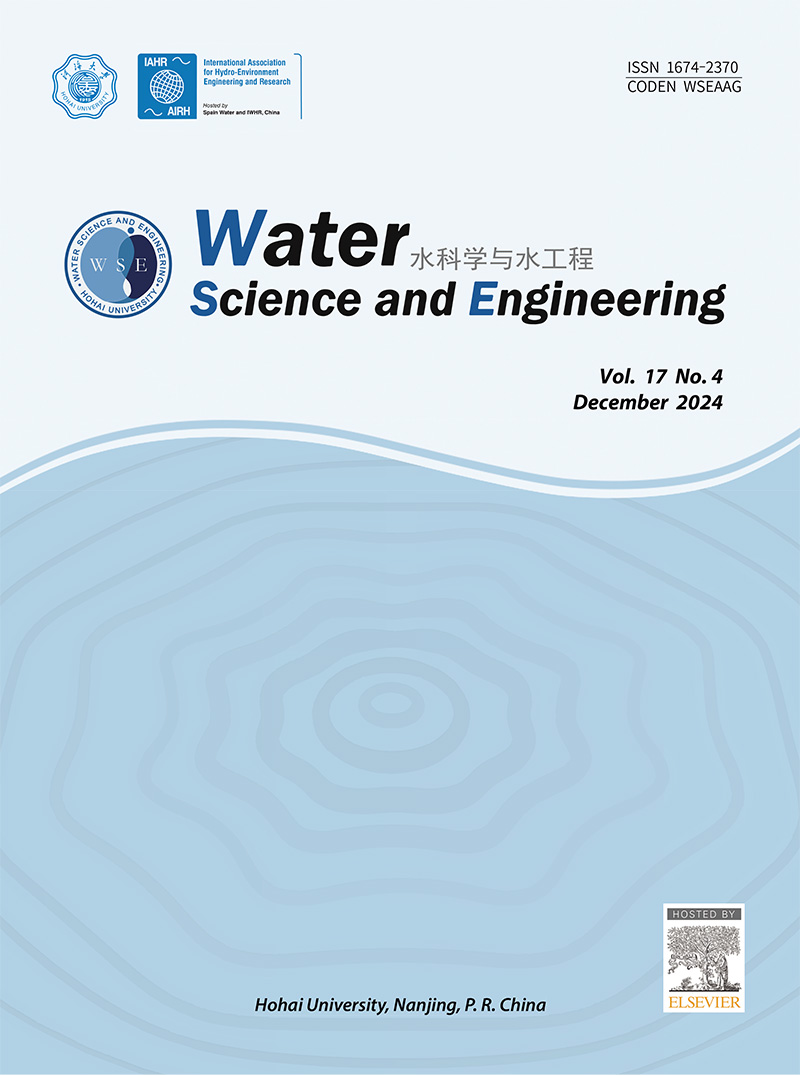利用ZIF-67和ZIF-67/GO纳米复合材料去除水中溴酸盐:优化及机理分析
IF 4.3
Q1 WATER RESOURCES
引用次数: 0
摘要
溴酸盐(BrO3−)是水处理过程中臭氧化过程中经常产生的有毒消毒副产物,被列为潜在的人类致癌物。因此,将其从饮用水中有效清除是公共卫生和环境安全的一个紧迫问题。本研究通过对比研究了合成的咪唑酸分子筛框架(ZIF)-67和ZIF-67/氧化石墨烯(GO)纳米复合材料对水中BrO3−的去除效果。对两种zif的形貌、组成和结晶度进行了表征。考察了4个独立参数(初始浓度、pH、吸附剂剂量和接触时间)对BrO3−去除率的影响。在实验值和预测值之间观察到很强的相关性。氧化石墨烯增强BrO3−的去除不仅通过与ZIF-67的协同作用,还通过改善分散和提供额外的官能团促进静电相互作用和吸附。采用Box-Behnken设计评估了各参数对BrO3−去除率的单独影响和交互影响,在pH值为4、初始BrO3−浓度为2 mg/L、ZIF-67/GO用量为1.5 g/L时,达到了约99.6%的最佳去除率。期望性分析进一步支持了优化过程。BrO3−的去除机制主要归因于孔隙度、静电相互作用和活性位点的吸附。与单独使用ZIF-67相比,ZIF-67/GO表现出优越的阴离子去除效率,突出了其在水处理中的应用潜力。本文章由计算机程序翻译,如有差异,请以英文原文为准。
Effective bromate removal from water utilizing ZIF-67 and ZIF-67/GO nanocomposites: Optimization and mechanism analysis
Bromate () is a toxic disinfection byproduct frequently formed during ozonation in water treatment processes and is classified as a potential human carcinogen. Its effective removal from drinking water is therefore a pressing concern for public health and environmental safety. This study investigated the removal of from water using the synthesized zeolite imidazolate framework (ZIF)-67 and ZIF-67/graphene oxide (GO) nanocomposites through a comparative approach. The morphology, composition, and crystallinity of both ZIFs were characterized. The effects of four independent parameters (initial concentration, pH, adsorbent dose, and contact time) on removal efficiency were examined. A strong correlation was observed between experimental and predicted values. GO enhanced removal not only through synergistic interactions with ZIF-67 but also by improving dispersion and providing additional functional groups that facilitate electrostatic interactions and adsorption. The Box–Behnken design was employed to evaluate both individual and interactive effects of the parameters on removal, achieving an optimum removal efficiency of approximately 99.6% using 1.5 g/L of ZIF-67/GO at a pH value of 4 with an initial concentration of 2 mg/L. The optimization process was further supported by desirability analysis. The removal mechanisms are primarily attributed to porosity, electrostatic interactions, and adsorption onto active sites. Compared to ZIF-67 alone, ZIF-67/GO demonstrated superior anion removal efficiency, highlighting its potential for water treatment applications.
求助全文
通过发布文献求助,成功后即可免费获取论文全文。
去求助
来源期刊

Water science and engineering
WATER RESOURCES-
CiteScore
6.60
自引率
5.00%
发文量
573
审稿时长
50 weeks
期刊介绍:
Water Science and Engineering journal is an international, peer-reviewed research publication covering new concepts, theories, methods, and techniques related to water issues. The journal aims to publish research that helps advance the theoretical and practical understanding of water resources, aquatic environment, aquatic ecology, and water engineering, with emphases placed on the innovation and applicability of science and technology in large-scale hydropower project construction, large river and lake regulation, inter-basin water transfer, hydroelectric energy development, ecological restoration, the development of new materials, and sustainable utilization of water resources.
 求助内容:
求助内容: 应助结果提醒方式:
应助结果提醒方式:


